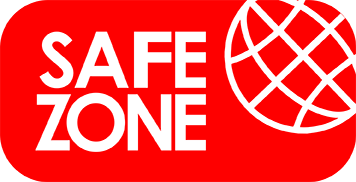PPE is equipment that will protect the user against health or safety risks at work. It can include items such as safety helmets, gloves, eye protection, high-visibility clothing, safety footwear and safety harnesses. It also includes respiratory protective equipment (RPE).

Safety Products

Hard Hats and Helmets
Hard hats and helmets protect the wearer from hazards that impact the head. They have a suspension system that moves the impact force though the body to feet, helping to reduce strain to the head, neck, and spine. These hard hats and helmets are ANSI rated and OSHA compliant. Types and classes combine to indicate the impact type (vertical only or vertical and angled) and level of electrical protection (none, low voltage, or high voltage) provided. Hard hats and helmets should be inspected regularly for structural integrity. Hard hats are used by construction workers, road crews, or where required by OSHA safety regulations.
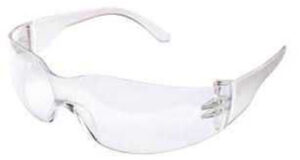
Safety Glasses
Safety glasses protect the eyes from liquids and flying debris.
Clear lenses do not filter light, making them a good choice for
wearing indoors or when moving between lighting conditions. Dark
lenses reduce light, glare, and eye strain when working outdoors
or in bright light. Amber (or yellow) lenses filter haze and
blue light to improve contrast in low-light conditions. Green
lenses filter infrared light created while welding, allowing
workers to wear personal eyewear.

Safety Goggles
Goggles fit tightly to the face to protect eyes from impact,
liquids, and particulates. A strap fits snuggly around the
head to hold the goggles in place. Protective goggles are often
worn in chemical manufacturing, healthcare, and construction.
Clear lenses do not filter light, making them a good choice for
wearing indoors or when moving between lighting conditions.
Dark lenses reduce light, glare, and eye strain when working
outdoors or in bright light. Amber (or yellow) lenses filter
haze and blue light to improve contrast in low-light conditions.
Green lenses filter infrared light created during welding operations.
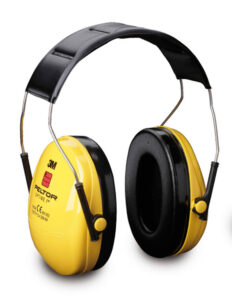
Hearing Protection
Hearing protection devices guard against hearing loss in environments with hazardous noise levels and wherever loud machinery operates. A noise reduction rating (NRR) is assigned to hearing protection to specify in decibels (dB) how much sound is reduced before reaching the ear. OSHA standards call for ear protection that reduces exposure to below 85 dB over the course of an average 8-hour work shift to avoid noise-induced hearing loss (NIHL). Earplugs fit into the ear canal and earmuffs fit over the ears. Earplugs and earmuffs provide similar ranges of protection. Noise-reducing communication headsets and earplugs have electronics that provide one- or two-way communication between workers.

Face Protection
Face protection equipment covers the face and sometimes the forehead and chin to protect it from dust, debris, and liquid splash. Eye protection is worn under the face shield to protect the eyes. The face shield visor extends from the forehead to the chin and allows customers to see the workpiece while protecting against impact. Crowns attach to headgear and cover the forehead and part of the top of the head and chin protectors attach to the bottom of a visor to protect the front and underside of the chin. Disposable face shields are generally worn in healthcare settings to protect against liquid splash

Respiratory Protection
Respiratory Protection equipment provides clean air for breathing and protects against harmful fumes or airborne contaminants. Airline filtration and CO monitors remove contaminants and check gas concentration in air supplies. Disposable respirators and dust masks block out airborne particles in emergency situations and dusty work areas. Emergency escape breathing apparatus and escape hoods provide short-term protection from contaminated air so people can evacuate an unsafe area. Fit-testing equipment determines whether a respirator properly fits the user. Respirators and gas masks work with filtration cartridges to supply clean air when working in potentially hazardous environments. SCBA (self-contained breathing apparatus) draws high-quality breathable air from a compressed-air cylinder and delivers it to the attached face mask. PAPR (powered air purifying respirator) pulls surrounding air through a filter and blows the purified air into the attached face mask.

Hand & Arm Protection
Hand and arm protection products protect workers from cuts, lacerations, burns, and other injuries. Safety gloves are worn on the hands and forearm to protect against injury and keep hands clean. Arm protection is worn from the wrist to upper arm to protect workers from cuts and burns. Gloves and sleeves are often ANSI/ISEA-rated for cut and needlestick resistance. Finger cots and finger protection help improve grip when working with small parts, reduce the risk of electrical discharge, and protect workers from cuts and burns.
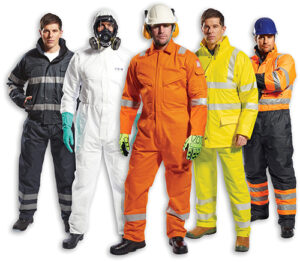
Protective Clothing
Protective clothing is worn over personal clothes to protect workers from environmental hazards. Aluminized clothing reflects heat when working near fire or in forges. Arc flash and flame-resistant clothing protects workers from flames or electrical hazards. Chemical-protective clothing includes encapsulated suits, coveralls, and sleeves to keep workers clean and protected from harsh chemicals. Cleanroom clothing is low-shedding and worn over a worker’s clothing to keep areas clean. Cut-resistant clothing protects against lacerations when working with knives and sharp edges. Cryogenic clothing protects against burns caused by extremely cold liquids. Hairnets, bouffants and beard nets prevent hair from falling into food and other substances. High-visibility clothing is made of bright colors and reflective materials. Liquid and particulate clothing protects workers from hazardous

High-Visibility Vests
High-visibility vests are made of brightly colored fabric or have reflective materials to make workers and pedestrians more visible to traffic and equipment operators. ANSI class indicates the amount of high-visibility fabric and reflective tape on the garment, as well as width of the reflective tape. Non-rated and Class 2 safety vests have lower levels of visibility than higher numbers. They are worn when required by OSHA or when working in warehouses, near traffic, and on construction sites.

Fall Protection Harnesses & Body Belts
Safety harnesses are used with self-retracting lifelines or shock-absorbing lanyards to connect a worker’s body to an anchor point. These fall-protection harnesses are secured around a worker’s shoulders, torso, and thighs. In the event of a fall, the harness spreads the force of the fall across the body and keeps the worker upright. Safety harnesses are often paired with accessories that add extra safety features to the harnesses or provide comfort or convenience to people wearing the harnesses. Body belts are worn around the waist. They connect to positioning and restraint lanyards to keep workers positioned properly and prevent them from falling over an edge.

Fire Fighting Clothing and Accessories
Fire-fighting clothing and accessories protect firefighters against heat, flames, impacts, and other on-the-job hazards. Fire hoods are worn under a helmet to provide heat and flame protection for your head, face, and neck. Fire and rescue boots are made of heat-resistant, waterproof materials to prevent foot injuries and keep your feet dry. Fire and rescue helmets withstand heat and resist punctures and impacts to protect your head. Turnout gear includes coveralls, jackets, and pants that offer heat and flame protection while maintaining comfort and mobility. Turnout gear storage racks keep fire-protection clothing and accessories organized and accessible.
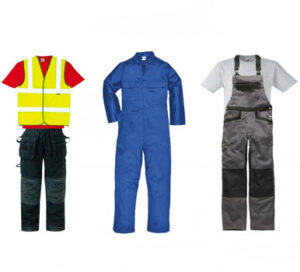
Work Clothing and Workwear
Workwear includes functional clothing and accessories for a range of work environments. Chemical warmers are worn inside gloves and shoes to keep hands and feet warm in extreme cold. Cooling vests keep people cool in hot work temperatures. General purpose work apparel includes jackets, coats, hats, and other garments for everyday use. Medical scrubs provide attire that’s well-suited to lab work and medical settings. Rainwear is made of waterproof material to keep workers dry in rain or washdown applications.

Safety Footwear
Footwear help protect feet from potential hazards such as impact, punctures, and chemicals. These work boots and shoes are ideal for use in warehouses, construction zones, and hospitals. Plain-toe work boots and shoes offer style for continued wear outside of the jobsite. Chemical-resistant boots and waders safeguard workers against chemicals and wet hazards and offer extended coverage to the hips or chest. Overboots and overshoes fit over footwear to shield shoes from water or physical, chemical, or electrical hazards. fire and rescue boots offer stability and traction.
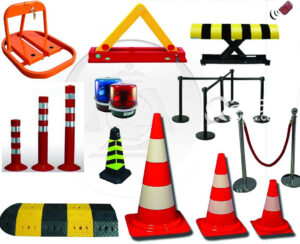
Traffic Control Equipment
Traffic-control equipment marks boundaries, creates barriers, and provides direction for managing traffic on roads and inside facilities. These traffic safety products help prevent collisions and traffic backups. Barrier tapes and pavement markers identify closed off areas, traffic lanes, survey sites, and more. Traffic barrels, drums, barricades, cones, and delineator posts form temporary lanes and block sections of road during road construction. Parking curbs, speed bumps, and stop/slow paddles help control traffic speed and flow. Traffic warning flags alert people to truck traffic hazards such as wide loads and nearby vehicles. Windsocks alert pilots and air traffic controllers to wind direction and speed and are used in industrial setting to indicate wind direction in the event of a gas or chemical leak.

Safety Storage
Safety storage includes cabinets, containers, and equipment for storing hazardous materials. Safety cabinets store and organize containers of chemicals, flammable liquids, corrosives, gases, and other hazardous materials. Safety cans and accessories are used to store, transport, dispense, and dispose of fuels, chemicals, solvents, and corrosives.
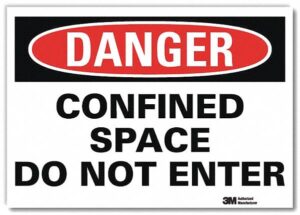
Signs & Facility Identification Products
Signs and facility identification products call attention to hazards, regulate traffic, mark equipment, and provide information to prevent accidents and comply with building codes and safety regulations. Safety signs communicate information and reminders about potential hazards and safety instructions and help prevent accidents and injuries. Security grounds signs provide directions, mark exits and entrances, restrict access to certain areas, and identify areas under surveillance. Exit signs, fire signs, and emergency situation signs identify escape routes and safety equipment to guide building evacuations and improve emergency management. Parking, traffic, and road construction signs provide guidance for navigating roadways and parking lots. Pipe markers identify the contents of internal and external piping. Valve tags are preprinted with numbers and standard abbreviations to relay important pipe content information, valve identification, or operation information.
